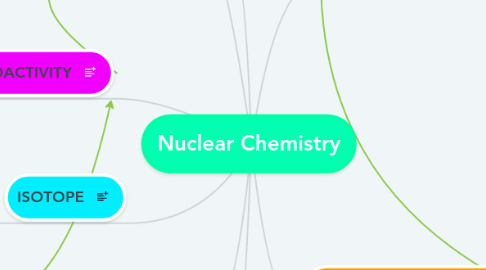
1. Chernobyl disaster of 1986
2. HALF-LIFE
2.1. Archaeological dating
2.1.1. Archaeologists use the half life of carbon-14 to determine the age of carbon containing material derived from plants or animals.
2.2. The life of a radioactive isotope is the time it takes for one half of the sample to decay.
3. RADIOACTIVITY
3.1. The emission of elementary particles by some atoms when their unstable nuclei disintegrate (see half-life). Materials composed of such atoms are radioactive. (See alpha radiation, beta radiation, and gamma radiation.)
4. ISOTOPE
4.1. Radioisotope
4.1.1. is unstable and continuously emits energy to form a more stable nucleus.
4.2. are atoms of the same element having a different number of neutrons.
5. RADIOACTIVITY DETECTION
5.1. Geiger counter
5.1.1. small portable device used for measuring radioactivity, it consists of a tube filled w/ argon gas that is ionized when it comes into contact with nuclear radiation.
6. FUSSION & FISSION
6.1. Fussion
6.1.1. occurs when 2 light nuclei join together to form a larger nucleus .
6.2. Fission
6.2.1. splitting part of a heavy nucleus into lighter nuclei and neutrons
7. NUCLEAR REACTION
7.1. Nucleus combines, splits, and emit radiation
7.2. Can involve protons, neutrons, and electrons
7.3. Associated w/ large energy changes
7.4. Atoms of one element are often converted into atoms of another element
7.5. Temperature, pressure, and concentrations do not affect the reaction.
8. RADIOACTIVE DECAY
8.1. Alpha
8.1.1. The radioactive decay of an atomic nucleus by emission of an alpha particle (two protons bound to two neutrons). When an element undergoes alpha decay, its atomic number decreases by two.
8.2. Beta
8.2.1. radioactive decay in which an electron is emitted.
8.3. Positron
8.3.1. Positron emission or beta plus decay (β+ decay) is a subtype of radioactive decaycalled beta decay, in which a proton inside a radionuclide nucleus is converted into a neutron while releasing a positron and an electron neutrino (νe). Positron emission is mediated by the weak force.
8.4. Gamma
8.4.1. type of radioactivity in which an unstable atomic nucleus dissipates energy by gamma emission, producing gamma rays. gamma decay in Science. gamma decay. A radioactive process in which an atomic nucleus loses energy by emitting a gamma ray (a stream of high-energy photons)
